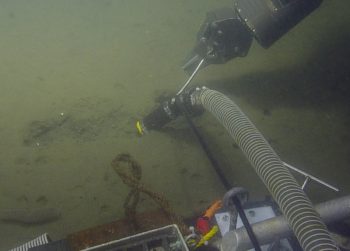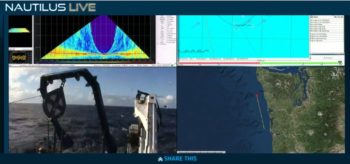Update July 3: Preliminary Findings from the Nautilus Meteorite Hunt
“In July 2018, Exploration Vessel Nautilus attempted to locate and recover fragments of a rare, large meteorite fall that was recently observed in NOAA’s Olympic Coast National Marine Sanctuary off the coast of Washington.
An overnight multibeam sonar survey on July 1 attempted to identify possible meteorite impact locations, but no obvious changes to the seafloor were observed.
On July 2, robot underwater vehicles, Hercules and Argus, were launched to conduct a 7-hour visual survey of the seafloor in a region identified to likely include the impact site.
While exploring this area, the Nautilus team collected several sediment samples using a suction hose sampler, magnetic plate, and sediment scoop. Upon recovering the vehicles, the team spent about six hours in the ship’s wet lab sifting and processing through these silty samples.
NASA Cosmic Dust Curator Marc Fries conducted an initial visual analysis of the samples collected, and his preliminary findings include two small fragments of fusion crust–meteorite exterior that melted and flowed like glaze on pottery as it entered the atmosphere.
Additional analysis will be conducted in the coming weeks to determine if these fragments indeed came from the massive meteorite fall seen entering the Pacific Ocean off Washington’s coast in March 2018.”
According to the expedition team, they will continue to post updates on this exciting research as they learn more.
Fall guy
On March 7, 2018, a bright meteorite (called a bolide) fall was observed about 15 miles (25 kilometers) off the coast of Grays Harbor County, Washington.
Ocean Exploration Trust is worked with scientists from Olympic Coast National Marine Sanctuary, NASA, and University of Washington to locate the meteorite fall.
Underwater vehicles
Exploration Vessel Nautilus mapped a 1 square kilometer area, and then conducted a search of the area with remotely operated underwater vehicles — Hercules and Argus — and recover any fragments located.
Support for this expedition comes from NOAA’s Office of Ocean Exploration and Research, Ocean Exploration Trust, and National Geographic Society.
Sea floor site
An analysis by NASA Cosmic Dust Curator Marc Fries, who is onboard Nautilus for the expedition, indicated this fall is approximately two tons of meteorites. Fries estimated that, at the fall site for the largest meteorite, there may be two to three meteorites for every 10 square meters of sea floor.
If meteorite fragments are found they will be shipped to the Smithsonian Institution in Washington, D.C. and become part of their research collections.
A remotely operated vehicle (ROV) dive will occur on July 2, 2018, from approximately 9am-4pm Pacific Time (weather dependent).
The public can explore with the Nautilus team in real-time on Nautilus Live!
Go to: www.nautiluslive.org
Also, go to this informative video about the meteorite hunt at:






